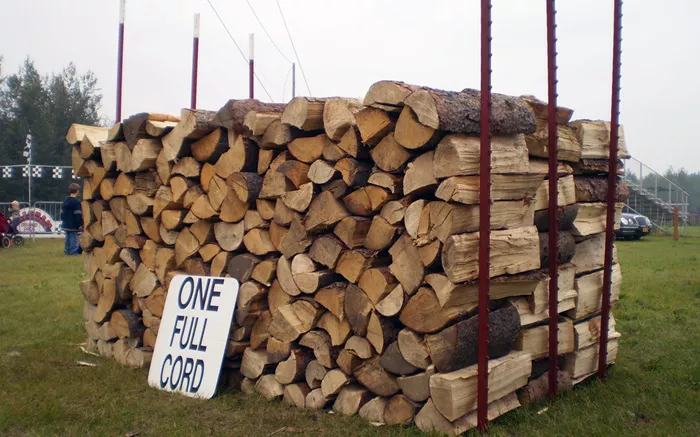A cord of wood is a standard measurement used to quantify firewood. Understanding the costs associated with a cord of wood involves several factors, including the type of wood, location, seasoning, and market conditions. This comprehensive guide provides detailed insights into what constitutes a cord of wood, factors influencing its cost, and typical price ranges.
Understanding a Cord of Wood
A cord of wood is defined as a stack of wood that measures 4 feet high, 4 feet wide, and 8 feet long, totaling 128 cubic feet. This measurement includes the air space between the pieces of wood, making a cord of wood appear larger than its actual volume when stacked. It’s important to note that a cord is a unit of volume, not weight or weight, which means that the actual weight of a cord can vary depending on the wood type and moisture content.
Types of Firewood and Their Impact on Price
The type of wood you choose affects both the price and the performance of the firewood. Here’s a breakdown of common wood types and their typical cost implications:
1. Hardwoods
Types: Oak, hickory, maple, cherry, ash.
Characteristics: Dense and heavy, hardwoods burn longer and produce more heat. They are less likely to spark and are ideal for long-lasting fires.
Cost Impact: Hardwoods are generally more expensive than softwoods. Prices can range from $200 to $500 per cord, depending on the type of hardwood and regional availability.
2. Softwoods
Types: Pine, fir, spruce, cedar.
Characteristics: Softwoods burn faster and hotter but don’t last as long as hardwoods. They produce more creosote, which can lead to chimney buildup if not properly maintained.
Cost Impact: Softwoods are typically less expensive than hardwoods, with prices ranging from $150 to $350 per cord.
3. Mixed Wood
Types: A combination of hardwoods and softwoods.
Characteristics: Offers a balance between burn time and heat output.
Cost Impact: Mixed wood is generally priced between $150 and $400 per cord, providing a more affordable option compared to pure hardwood.
4. Seasoned vs. Green Wood
Seasoned Wood: Wood that has been dried for at least six months. It burns more efficiently, produces less smoke, and is easier to ignite.
Green Wood: Wood that has just been cut and has high moisture content. It is harder to burn and produces more smoke and creosote.
Cost Impact: Seasoned wood is more expensive due to the additional processing required. Green wood is less expensive but may require additional drying time and effort.
See also: How To Remove A Stripped Screw: A Step-By-Step Guide
Factors Influencing the Cost of a Cord of Wood
Several factors can affect the price of a cord of wood:
1. Location
Regional Variations: Prices can vary significantly based on geographic location due to differences in supply and demand, transportation costs, and availability of wood types. Urban areas often have higher prices compared to rural areas.
Climate: In colder regions, where firewood is in higher demand during winter, prices may be higher compared to milder climates.
Seasonal Demand:
Winter Peak: Prices often rise during the winter months when demand is highest. In contrast, prices may decrease during the off-season or summer months.
Weather Conditions: Harsh weather conditions can affect the availability and price of firewood.
2. Delivery and Handling
Delivery Fees: Many suppliers charge extra for delivery, especially if the delivery is to a remote or difficult-to-access location. Some sellers offer bundled pricing that includes delivery.
Stacking Fees: Some suppliers offer to stack the wood at your location for an additional fee.
3. Wood Quality and Preparation
Processing: Higher-quality wood that is properly seasoned and prepared typically costs more. Wood that is cut, split, and stacked is more expensive compared to unprocessed wood.
Condition: Well-maintained and properly stored wood is more costly but performs better.
Typical Price Ranges for a Cord of Wood
Here’s an overview of typical price ranges for a cord of wood:
Hardwood: $200 to $500 per cord. Prices can vary based on wood type (e.g., oak, hickory) and regional availability.
Softwood: $150 to $350 per cord. Common softwoods like pine and fir are usually less expensive.
Mixed Wood: $150 to $400 per cord. This option offers a balance between cost and performance.
How to Purchase Firewood
When purchasing a cord of wood, consider the following tips to ensure you get a good deal:
1. Verify the Measurement
Full Cord: Confirm that you are receiving a full cord of wood, as some sellers may offer less than a true cord or use different measurements like face cords.
Stacking: Check if the price includes stacking or if there is an additional charge.
2. Check for Seasoning
Seasoned vs. Green: Ensure the wood is seasoned if you plan to use it immediately. Seasoned wood is ready to burn efficiently and produce less smoke.
3. Compare Prices
Multiple Suppliers: Compare prices from different suppliers to find the best deal. Prices can vary widely based on location and other factors.
4. Ask About Delivery
Delivery Options: Inquire whether delivery is included in the price or if there are extra charges. Delivery costs can affect the total price of the wood.
Conclusion
Understanding the cost of a cord of wood involves considering various factors, including wood type, seasoning, location, and market conditions. By knowing the details and typical price ranges, you can make an informed decision when purchasing firewood. Whether preparing for winter or managing seasonal needs, having a clear understanding of these aspects will help you efficiently and cost-effectively meet your firewood requirements.
Related Topics:

